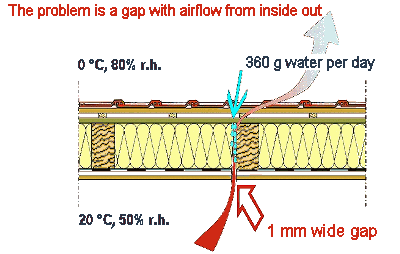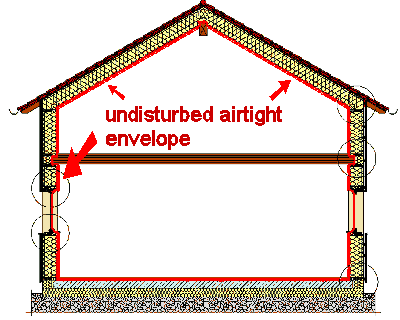Table of Contents
Airtight construction
Why build an airtight house?
Indoor air has a higher water vapour content (absolute humidity) than outside air - if not dehumidified. In a cold climate, indoor air is cooled during flow inside-out (called exfiltration). The colder air can not keep the high amount of water vapour - condensing will occur at a certain place within the construction. This may lead to serious damage. In hot and humid climates, there the occupied rooms are going to be cooled, the airflow will be dominated in the direction outside-in (called infiltration) and will cause the same mositure problem. The process described here is the main reason why external building structure has to be built airtight. For the passive house standard, a really good airtightness is required - the airflows discussed here will be negligible, which is one of the big advantages of the standard - without moisture problems, the components can last forever.
How to make a building airtight
The key to making a building airtight is the principle of a “continuous, tight building envelope“. Read more...
The “level of airtightness“ can be determined by creating high and low pressure inside the building. Read more...
Airtightness is an important requirement for any energy-efficient building, however, it is not the most important one (as sometimes suggested in popular publications - the most important requirement is good thermal insulation). Example: Passing the blower door test is a necessary prerequisite for the functioning passive building; yet it is not sufficient. Example: a conventional aircraft shell is airtight (much more airtight than a Passive House needs to be), but it is not insulated to Passive House quality In aircrafts there is abundant heat available for cabin heating.
See also
Airtightness and airtightness measurement
Read also in Ukrainian
Airtight envelope - basics
Checklist: Test reports of airtightness measurements
Record of an airtightness test: Sample Documents for Building Certification
Carrying out airtightness measurements in Passive Houses
How to make a building airtight
Airtightness Approaches for Deep Renovation


